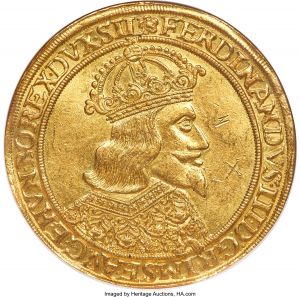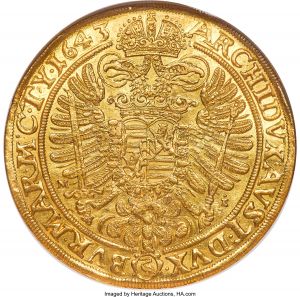Difference between revisions of "Silesia 1643-MI 10 ducats Fr-210"
(added link) |
m (Text replacement - "|1650 10 ducats, Breslau mint" to "|1650-GH 10 ducats, Breslau mint") |
||
| Line 28: | Line 28: | ||
* [[Silesia 1646-MI 1/2 thaler KM-340|1646-MI half thaler, Breslau mint, Ferdinand III]] | * [[Silesia 1646-MI 1/2 thaler KM-340|1646-MI half thaler, Breslau mint, Ferdinand III]] | ||
* [[Silesia 1650-GH thaler Dav-3219|1650 thaler, Breslau mint]] | * [[Silesia 1650-GH thaler Dav-3219|1650 thaler, Breslau mint]] | ||
| − | * [[Silesia 1650 10 ducats|1650 10 ducats, Breslau mint]] | + | * [[Silesia 1650 10 ducats|1650-GH 10 ducats, Breslau mint]] |
* [[Coins and currency dated 1643]] | * [[Coins and currency dated 1643]] | ||
[[Category:Selections from Heritage sale 3096]][[Category: Gold ducats of Europe]] | [[Category:Selections from Heritage sale 3096]][[Category: Gold ducats of Europe]] | ||
Latest revision as of 14:55, 5 September 2025
This specimen was lot 30106 in Heritage auction 3096 (Dallas, TX, March 2021), where it sold for $78,000. The catalog description[1] noted,
"Only the Second Example of this Date We Have Located. Austria - Ferdinand III gold 10 Ducat 1643 AU Details (Obverse Graffiti) NGC, Breslau mint. Michael Jan as mintmaster. A distinctive issue, characterized by its singular depiction of Ferdinand III wearing an open, mitred crown and a highly ornamented brocade. Rarely encountered at auction in any condition, we are aware of only one other representative of this date having been available, though without graffiti, which brought 120,000 Euros in June 2016. We would also note that, in his definitive study, Miller zu Aichholz knew of a single specimen in Görlitz, with none contained in the Vienna Coin Cabinet. As a whole, the visual presentation of this coin is markedly superb. The devices have been deeply and fully rendered, imbued with squared-off edges, while remnants of luster brighten the flan, particularly on the reverse. Closer inspection of the obverse reveals "Z" and "X" shaped scratches to the right of the portrait, which may represent the denomination written in Roman numerals--a hallmark observed on larger-sized gold multiples that may have been tied to their use as military expenditures during the Thirty Years' War, as Ferdinand took over full command of the army after Wallenstein's downfall. From the Paramount Collection."
This issue seems to be struck using thaler dies (see Dav-3219/KM 345.1).
Recorded mintage: unknown.
Specification: 35 g, 0.986 fine gold, this specimen 34.55 g.
Catalog reference: KM-Unl., Fr-210, Horsky-Unl., Julius-Unl., Saurma-Jeltsch-Unl., F&S-Unl., Herinek-48, MzA-141.
- Cuhaj, George S., and Thomas Michael, Standard Catalog of World Coins, 1601-1700, 6th ed., Iola, WI: Krause Publications, 2014.
- Friedberg, Arthur L. and Ira S. Friedberg, Gold Coins of the World, From Ancient Times to the Present, 9th ed., Clifton, NJ: Coin and Currency Institute, 2017.
- Craig, William D., Germanic Coinages: Charlemagne through Wilhelm II, Mountain View, CA: 1954.
- [1]Bierrenbach, Cristiano and Warren Tucker, Heritage World and Ancient Coins Auction 3096, featuring the Paramount Collection of World & Ancient Coins, Dallas, TX: Heritage Auction Galleries, 2021.
Link to:
- 1642 thaler, Kuttenberg mint
- 1642-MI thaler, Breslau mint, Ferdinand III
- 1642 double ducat, Innsbruck mint
- 1642 10 ducats, Vienna mint
- 1644 10 ducats, Graz mint
- 1644 10 ducats, Prague mint
- 1645 double ducat, Breslau mint
- 1645 10 ducats, Vienna mint
- 1646 ducat, Breslau mint
- 1646-MI half thaler, Breslau mint, Ferdinand III
- 1650 thaler, Breslau mint
- 1650-GH 10 ducats, Breslau mint
- Coins and currency dated 1643

